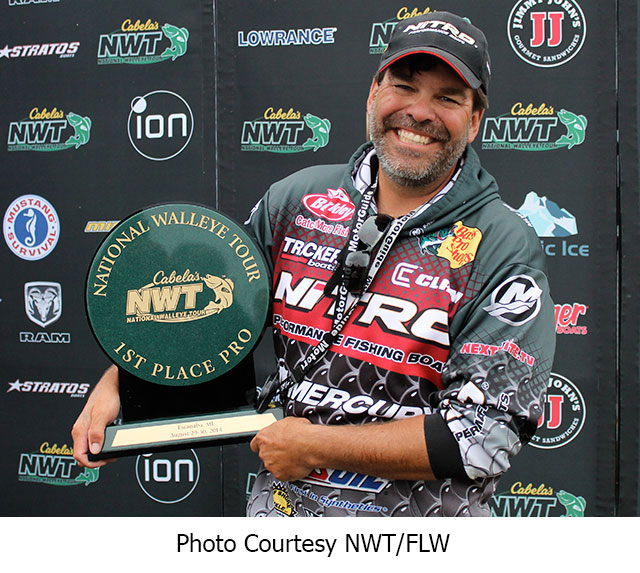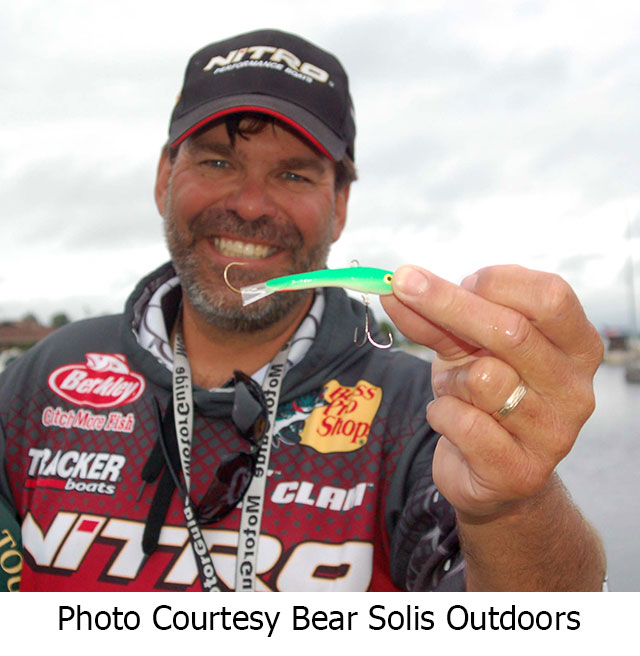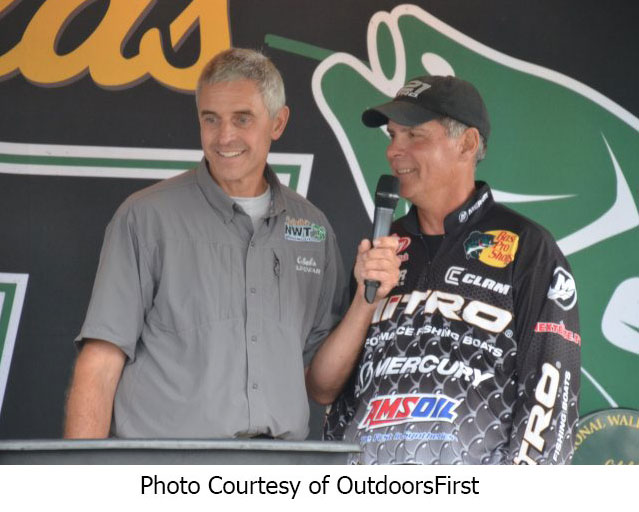Press Release
For Immediate Release:
September 2, 2014
Kavajecz Casts to a Win at NWT Escanaba Event!
Parsons Makes Come-back to take 2nd
On a well-known and frequently fished walleye haunt like the Bays de Noc area of Lake Michigan, one would think that every conceivable tactic to catch walleyes would have already been explored. But that was proven to not be the case during the recent Cabela’s National Walleye Tour (NWT) event held out of Escanaba, Michigan. TNB Staffers and Hall of Fame anglers Keith Kavajecz and Gary Parsons used an innovative and little utilized casting technique with a lure designed primarily for ice fishing to take 1st and 2nd respectively and best the field of some of the country’s top walleye fishermen.
 Known primarily as a “trolling bite” fishery, the walleyes of Lake Michigan’s “north end” are notorious for being tough to catch when the winds lay down this time of year. “Most of the walleyes here relate to structure like humps and breaks, and because of the clear water tend to be finicky unless you have a good chop on the surface”, explained Kavajecz. Parsons added, “This was a tactic we had never used here before, but it’s had some success in other areas of the country and considering how the fish were setting up, it just made sense to give it a try here.”
Known primarily as a “trolling bite” fishery, the walleyes of Lake Michigan’s “north end” are notorious for being tough to catch when the winds lay down this time of year. “Most of the walleyes here relate to structure like humps and breaks, and because of the clear water tend to be finicky unless you have a good chop on the surface”, explained Kavajecz. Parsons added, “This was a tactic we had never used here before, but it’s had some success in other areas of the country and considering how the fish were setting up, it just made sense to give it a try here.”
According to Kavajecz, it was imperative to be on the fish in order to catch them. “We had found a good milk-run of spots by running around graphing for fish with our Lowrance HDS12 Gen 2 units.” Explained Kavajecz, “When a fish was marked, I’d scroll back on sonar and put a weigh point right on that marked fish, then move upwind in rough conditions or to the side in calm conditions and cast to those individual fish.” Parsons added that the tactic was just more efficient that trolling, “allowing us to target individual fish or small pods of fish on these structures rather than spending time setting up trolling passes to try and hit them.”
As with any tactic, precise boat control played a huge role. “I’d use the Key Fob control for my MotorGuide Xi5 bowmount trolling motor and once I positioned the boat where I wanted it, set the motor in “Anchor Mode” to hold the boat where I wanted it.” offered Keith, “That motor could then hold my position, whether I was in 4 foot rollers or calm water, and the key fob made making small adjustments to my position effortless.”
The lures the guys were casting were Moonshine Lures’ #3 Shiver Minnows – a horizontal-minnow-like jigging lure. The bait’s unique minnow shape and fan tail give this lure an enticing action as it swings off to the side on the up-stroke and smoothly glides back down on the free-fall. “Cadence was key”, Kavajecz said, “We had to work the bait close to bottom without hitting bottom too much. You want to sweep the rod up 3 foot – almost to the point of snapping it up. That would make the lure dart to one side. Then immediately drop the rod tip to give it slack and let the bait glide as you reeled in the slack line. Then,  just before the lure would hit bottom, you repeat the cadence.” Keith explained that most bites would come on the drop when there was slack in the line, so as he went to make his next pull, he’d feel the weight and set the hook hard.
just before the lure would hit bottom, you repeat the cadence.” Keith explained that most bites would come on the drop when there was slack in the line, so as he went to make his next pull, he’d feel the weight and set the hook hard.
Fine-tuning the presentation, the guys would replace the small “ice” treble on the belly of the lure with a #4 Mustad Triple Grip Treble (model TG58BN). This gave the bait a bigger “bite” for better hooking and the inward bend of the Triple Grip help keep fish on. In general “glide” lures like these are heavy and not the best hooking lures because the heavy body can be more easily thrown during a long fight. A second advantage is that with the inward bend the Triple Grips seemed to pick up less moss and fewer Zebra Mussels when the baits did hit bottom.
Proper rigging for this tactic was also important to success. The guys utilized a bright colored main line – 8# test Berkley Nanofil in Hi-Vis Chartreuse, in order to better help them see when the bait made bottom contact. The no-stretch of this line also gave it the sensitivity to feel everything the lure came in contact with as well as making long-distance hook-sets more productive. “These fish hit and fought really hard so a strong line like Nanofil was crucial, “ stated Kavajecz, “Nanofil is also really thin so it reduces the amount of loop in the line in when fishing in the wind. To help cut down on visibility and add some protection from Zebra Mussels, the guys used a 3 foot leader from the main line to the lure utilizing 10# test Berkley Trilene 100% Fluorocarbon. “The fluorocarbon is thicker so doesn’t get in zeeb crevices as much,” said Parsons, “We had to be constantly checking for nicks in the line – those Zebra Mussels are like fishing in razor blades and we had to continuously retie our set-ups.”
 Parsons added, “This tournament shows the importance of tournament angling to the industry. The guy that owns Moonshine Lures is going to have his life change overnight. This is going to change Great Lakes structure fishing forever. The people that say there is no innovation in walleye fishing are dead wrong. You can never stop innovating and never stop learning in this sport.”
Parsons added, “This tournament shows the importance of tournament angling to the industry. The guy that owns Moonshine Lures is going to have his life change overnight. This is going to change Great Lakes structure fishing forever. The people that say there is no innovation in walleye fishing are dead wrong. You can never stop innovating and never stop learning in this sport.”
The guys were so excited about what they learned this past week using this tactic that plans were immediately made to shoot an upcoming episode of The Next Bite TV show on the technique. Look for that to air in early 2015.
Keith and Gary would like to thank their sponsors, Tracker/Nitro Boats, Bass Pro Shops, Mercury Outboards, MotorGuide Electric Motors, Berkley Soft Baits, Berkley Lines, Berkley Hard Baits, AMSOIL, Lowrance Electronics, Mustad Hooks, Off Shore Tackle, Strike King, Power-Pole, Smooth Moves Suspension Seat Mounts, EGO Nets, Clam Ice Fishing, Cisco Fishing Systems, G2 Gemini, AIM (Anglers Insight Marketing), Moonshine Lures and The Next Bite Media.










